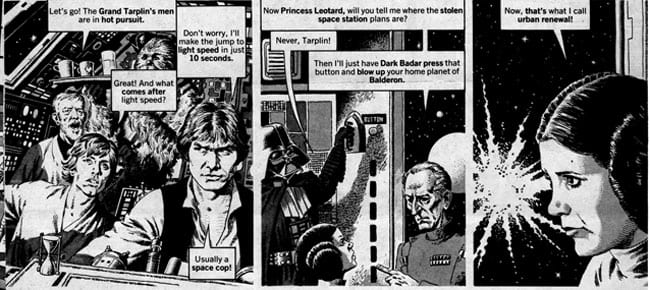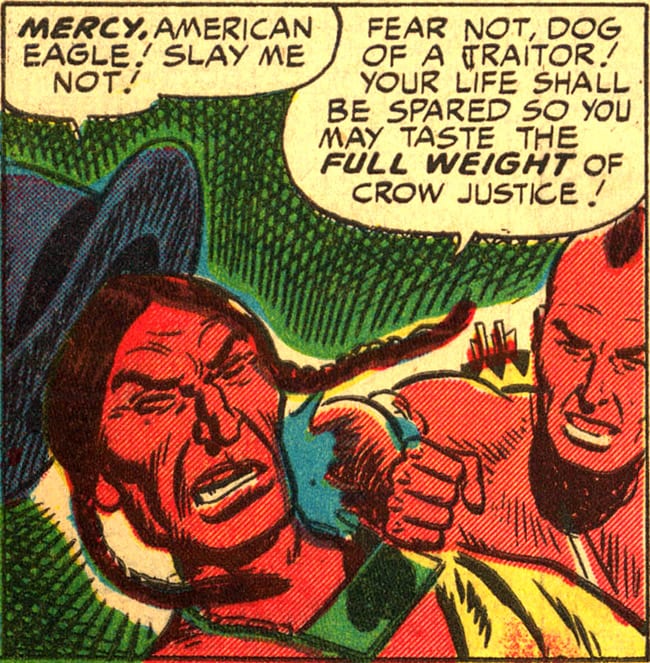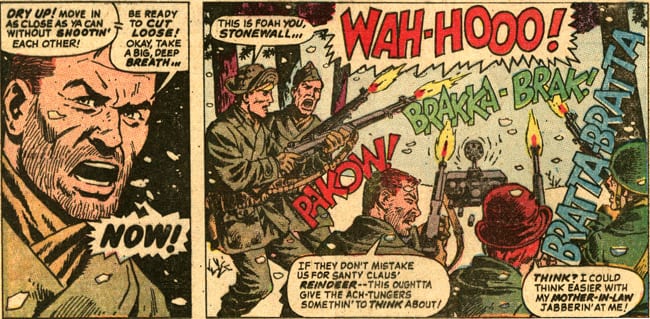
John Powers Severin (December 26th, 1921—February 12, 2012) is legendary as one of the most prolific and long-lived of all comics artists, producing quality work well into his 90s. Almost alone of the original EC comics artists, Severin kept working, penciling and inking stories and miniseries for Marvel, DC, Dark Horse and many other publishers into the early decades of the 21st century, long after most of his peers were either dead or retired. Though never really a “fan favorite” artist, Severin was well-respected by his editors, peers and the discerning cadre of fans who followed his work for decades in Mad, Cracked, Crazy, Sgt. Fury and His Howling Commandos, The Incredible Hulk, King Kull, “American Eagle” in Prize Comics Western, Journey Into Mystery, Savage Tales, Bat Lash, Witchfinder, Two-Gun Kid, The Rawhide Kid, Blazing Combat, Our Army at War, The ‘Nam, Semper Fi, Our Fighting Forces, Creepy, Eerie, Two-Fisted Tales, Frontline Combat, The Simpsons Treehouse of Horror and too many other titles to be listed here. Because of his long career and highly developed work ethic, Severin was one of the most prodigious comics creators ever, creating thousands of pages of comic-book art, covers, portfolio plates, ad artwork and illustrations, despite never getting any formal art training.

Although he did not possess a flashy style, his meticulous draftsmanship and attention to details of costuming, setting, weaponry and realistic facial expressions and body language made every job he ever drew memorable, dramatic and believable. His solid inking could elevate and dominate the most pedestrian pencil art in much the same way that Wally Wood’s inking did, bringing to it a higher level of visual interest than a lesser inker could provide. Because of his penchant for history, Severin is sometimes typed as a “war artist,” but besides war stories, he wound up illustrating many, many Westerns and other period pieces from just about every era in history. However, his knowledge of previous eras also lent that same type of verisimilitude to his infrequent fantasy and horror stories, especially for King Kull in the early ’70s, done in collaboration with his sister, Marie (Marie, who penciled the Kull comic, had also been John’s colorist at EC two decades earlier before becoming a well-respected superhero and humor artist over at Marvel). Severin must have had some affection for the Kull character, for he did one portfolio while still drawing the Kull comic; then, after leaving the title, he did a second one. One of Severin’s Kull drawings for the portfolios even wound up being used as the art for a rare and highly prized 7-Eleven Slurpee cup featuring King Kull, from a series of cups that showcased all of the major Marvel characters of the mid-’70s, including Conan the Barbarian, Doc Savage, Dracula and the usual crew of superheroes.

But during the ’60s and ’70s, Severin seemed to be everywhere, especially as the artist-in-residence at Cracked, where he did almost all of the covers and usually several features each issue, producing additional Cracked covers for paperback reprints. After being one of the founding artists for Mad, he began working for the Mad imitation Cracked in the late ’50s and stayed there for nearly 40 years, because he was paid as well as the Mad contributors and was allowed to contribute several features in every issue. In addition to the mountain of work he produced for Cracked, he was simultaneously working for Marvel, Warren and DC. Severin was the consummate professional who editors and art directors knew could draw anything, from a Roman legionary to Cracked mascot Sylvester P. Smythe, and everything in between. Like fellow EC colleagues Jack Davis and Frank Frazetta, Severin could crank out great humor comics with the same facility he drew war, Western and historical tales. Severin was nothing if not versatile, though his style was always instantly recognizable and remarkably consistent in its quality. Even to the last, it didn’t seem that Severin had dropped a line.

John Severin was born Dec. 26, 1921 in Jersey City, New Jersey. His high school classmates at the High School of Music and Art included many future comics and cartooning luminaries such as future EC editor Harvey Kurtzman, Mad artist Al Jaffee and future collaborator, the inimitable Will Elder. Al Feldstein was another classmate, but was one who never liked Severin’s work even though he did assign the Severin-Elder team some stories for EC’s science fiction titles. Feldstein never used him at Mad when he took over as editor after Harvey Kurtzman’s abrupt departure, even though Wally Wood and Jack Davis, two of the other founding Mad artists, drew hundreds of pages for Mad. Severin’s work on those nine early issues has been endlessly reprinted in Mad paperbacks since the ’50s, so he was still earning reprint fees from that work decades after he did it, when he was in direct competition with Mad over at Cracked.

Severin broke into the comics business in 1947, drawing a crime story for the Simon and Kirby shop over at Crestwood Publishing. He was soon working directly for Crestwood as a writer/editor/artist for Prize Comics Western. His “American Eagle” strip about an Indian chief was one of the most realistic and non-stereotyped Native American characters in 1950s comics. It was intelligent, well-written and superbly drawn by Severin and Elder (with occasional assists from the likes of Al Williamson, Roy Krenkel and Frank Frazetta). Done in collaboration with Elder and writer Colin Dawkins, the “American Eagle” strips Severin created are a neglected masterpiece, worthy of revival in reprint volumes. While working for Crestwood, Severin’s stories and covers appeared in almost every issue of Prize Comics Western from #73 through #113. After leaving Crestwood to work at EC for Harvey Kurtzman, Severin filled in for him as the editor of Two-Fisted Tales for three memorable issues (#37-#39) in which he drew every story and all of the covers.

American Eagle, Sgt. Fury, King Kull and the Incredible Hulk are probably Severin’s best-known characters, because he had the longest runs with them. Although Joe Kubert is the artist most associated with Sgt. Rock, Severin’s handful of Rock stories are equally dramatic and masterful, as are all of the many war stories and covers he did over the years. He was recognized for his continuing artistic excellence on several occasions, winning the Alley Award in 1967 and 1968 for Sgt. Fury and His Howling Commandos as Best War Title. He was nominated for a Shazam Award in 1973 as the Best Inker (Humor Division), received the Cartoon Art Museum’s 2001 Spanky Award and was inducted into the Will Eisner Comics Hall of Fame in 2003. His artwork was exhibited three times at the Words & Pictures Museum in Northampton, MA, including being featured in the museum’s grand opening show, which ran from Oct. 9, 1992 through Jan. 5, 1993.

John Severin is survived by his wife, his children, grandchildren and great-grandchildren, and his sister Marie. Interestingly enough, many of Severin’s surviving family members are in the comics or entertainment business, including his son, John Severin, Jr. (also an artist), the head of Bubblehead Publishing; his daughter, Ruth Larenas, a producer for that company; and his grandson, John Severin III, a music producer and recording engineer.






